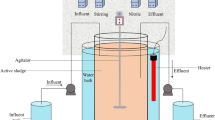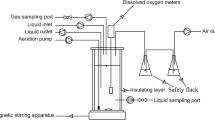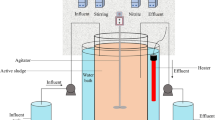Abstract
Nitrous oxide (N2O) accumulation in biological nitrogen removal has drawn much attention in recent years; however, nitric oxide (NO) accumulation in denitrification was rarely studied. In this study, NO and N2O accumulation during nitrite denitrification in a lab-scale sequencing batch reactor (SBR) were investigated. Results showed that low pH (< 7) and high influent loading (> 360:90) (COD:NO2−-N) caused serious NO and N2O accumulation. The maximal NO accumulation of 4.96 mg L−1 was observed at influent loading of 720:180 and the maximal N2O accumulation of 46.29 mg L−1 was found at pH of 6. The NO accumulation was far higher than the values reported in previous studies. In addition, the high NO accumulation could completely inhibit the activities of reductases involved in denitrification. High NO and N2O accumulation were mainly caused by significant free nitrous acid (FNA) and NO inhibition at low pH and high influent loading. There were significant differences on NO and N2O accumulation at different carbon to nitrogen (COD/N). Low COD/N (≤ 4) could mitigate NO accumulation, but led to high N2O accumulation. It is speculated that NO accumulation is related to the rapid denitrification with accumulated electron in anaerobic stage at high COD/N. N2O accumulation is attributed to intense electron competition at low COD/N. High dissolved oxygen (DO) of 4.04 mg L−1 was detected during NO detoxification in this experiment, which is speculated to be partly caused by NO dismutation.



Similar content being viewed by others
References
Adouani N, Limousy L, Lendormi T, Sire O (2015) N2O and NO emissions during wastewater denitrification step: influence of temperature on the biological process. Comptes Rendus Chimie 18:15–22. https://doi.org/10.1016/j.crci.2014.11.005
Alinsafi A, Adouani N, Béline F, Lendormi T, Limousy L, Sire O (2008) Nitrite effect on nitrous oxide emission from denitrifying activated sludge. Process Biochem 43:683–689. https://doi.org/10.1016/j.procbio.2008.02.008
APHA (2005) Standard methods for the examination of water and wastewater. American Public Health Association (APHA), Washington
Bergaust L, Mao Y, Bakken LR, Frostegard A (2010) Denitrification response patterns during the transition to anoxic respiration and posttranscriptional effects of suboptimal pH on nitrous oxide reductase in Paracoccus denitrificans. Appl Environ Microbiol 76:6387–6396. https://doi.org/10.1128/AEM.00608-10
Blum J-M, Su Q, Ma Y, Valverde-Pérez B, Domingo-Félez C, Jensen MM, Smets BF (2018) The pH dependency of N-converting enzymatic processes, pathways and microbes: effect on net N2O production. Environ Microbiol 20:1623–1640. https://doi.org/10.1111/1462-2920.14063
Brotto AC, Kligerman DC, Andrade SA, Ribeiro RP, Oliveira JL, Chandran K, de Mello WZ (2015) Factors controlling nitrous oxide emissions from a full-scale activated sludge system in the tropics. Environ Sci Pollut Res Int 22:11840–11849. https://doi.org/10.1007/s11356-015-4467-x
Castro-Barros CM, Rodríguez-Caballero A, Volcke EIP, Pijuan M (2016) Effect of nitrite on the N2O and NO production on the nitrification of low-strength ammonium wastewater. Chem Eng J 287:269–276. https://doi.org/10.1016/j.cej.2015.10.121
Ettwig KF et al (2010) Nitrite-driven anaerobic methane oxidation by oxygenic bacteria. Nature 464:543–548
Kim EW, Bae JH (2000) Alkalinity requirements and the possibility of simultaneous heterotrophic denitrification during sulfur-utilizing autotrophic denitrification. Water Sci Technol 42:233–238. https://doi.org/10.1038/nature08883
Klaus S, Sadowski M, Jimenez J, Wett B, Chandran K, Murthy S, Bott CB (2017) Nitric oxide production interferes with aqueous dissolved oxygen sensors. Environ Eng Sci 34:687–691. https://doi.org/10.1089/ees.2016.0634
Li C, Wang T, Zheng N, Zhang J, Ngo HH, Guo W, Liang S (2013) Influence of organic shock loads on the production of N2O in denitrifying phosphorus removal process. Bioresour Technol 141:160–166. https://doi.org/10.1016/j.biortech.2013.03.117
Li W, Zheng P, Guo J, Ji J, Zhang M, Zhang Z, Zhan E, Abbas G (2014) Characteristics of self-alkalization in high-rate denitrifying automatic circulation (DAC) reactor fed with methanol and sodium acetate. Bioresour Technol 154:44–50. https://doi.org/10.1016/j.biortech.2013.11.097
Liu B, Frostegard A, Bakken LR (2014) Impaired reduction of N2O to N2 in acid soils is due to a posttranscriptional interference with the expression of nosZ. MBio 5:e01383–e01314. https://doi.org/10.1128/mBio.01383-14
Lu H, Chandran K (2010) Factors promoting emissions of nitrous oxide and nitric oxide from denitrifying sequencing batch reactors operated with methanol and ethanol as electron donors. Biotechnol Bioeng 106:390–398. https://doi.org/10.1002/bit.22704
Ni B-J, Yuan Z (2013) A model-based assessment of nitric oxide and nitrous oxide production in membrane-aerated autotrophic nitrogen removal biofilm systems. J Membr Sci 428:163–171. https://doi.org/10.1016/j.memsci.2012.10.049
Pan Y, Ye L, Ni B-J, Yuan Z (2012) Effect of pH on N2O reduction and accumulation during denitrification by methanol utilizing denitrifiers. Water Res 46:4832–4840. https://doi.org/10.1016/j.watres.2012.06.003
Pan Y, Ni BJ, Bond PL, Ye L, Yuan Z (2013a) Electron competition among nitrogen oxides reduction during methanol-utilizing denitrification in wastewater treatment. Water Res 47:3273–3281. https://doi.org/10.1016/j.watres.2013.02.054
Pan Y, Ni BJ, Yuan Z (2013b) Modeling electron competition among nitrogen oxides reduction and N2O accumulation in denitrification. Environ Sci Technol 47:11083–11091. https://doi.org/10.1021/es402348n
Ribera-Guardia A, Pijuan M (2017) Distinctive NO and N2O emission patterns in ammonia oxidizing bacteria: effect of ammonia oxidation rate, DO and pH. Chem Eng J 321:358–365. https://doi.org/10.1016/j.cej.2017.03.122
Riya S, Zhou S, Kobara Y, Sagehashi M, Terada A, Hosomi M (2015) Influence of nitrogen loading and plant nitrogen assimilation on nitrogen leaching and N2O emission in forage rice paddy fields fertilized with liquid cattle waste. Environ Sci Pollut Res Int 22:5762–5771. https://doi.org/10.1007/s11356-014-3811-x
Schulthess RV, Kühni M, Gujer W (1995) Release of nitric and nitrous oxides from denitrifying activated sludge. Water Res 29:215–226. https://doi.org/10.1016/0043-1354(94)E0108-I
Wang Y, Fang H, Zhou D, Han H, Chen J (2016a) Characterization of nitrous oxide and nitric oxide emissions from a full-scale biological aerated filter for secondary nitrification. Chem Eng J 299:304–313. https://doi.org/10.1016/j.cej.2016.04.050
Wang Y, Lin X, Zhou D, Ye L, Han H, Song C (2016b) Nitric oxide and nitrous oxide emissions from a full-scale activated sludge anaerobic/anoxic/oxic process. Chem Eng J 289:330–340. https://doi.org/10.1016/j.cej.2015.12.074
Wu G, Zhai X, Li B, Jiang C, Guan Y (2014) Endogenous nitrous oxide emission for denitrifiers acclimated with different organic carbons. Procedia Environ Sci 21:26–32. https://doi.org/10.1016/j.proenv.2014.09.004
Wu J, Zhang J, Jia W, Xie H, Gu RR, Li C, Gao B (2009) Impact of COD/N ratio on nitrous oxide emission from microcosm wetlands and their performance in removing nitrogen from wastewater. Bioresour Technol 100:2910–2917. https://doi.org/10.1016/j.biortech.2009.01.056
Yan X, Zheng J, Han Y, Liu J, Sun J (2017) Effect of influent C/N ratio on N2O emissions from anaerobic/anoxic/oxic biological nitrogen removal processes. Environ Sci Pollut Res 24:23714–23724. https://doi.org/10.1007/s11356-017-0019-x
Zhang S, Liu F, Xiao R, Li Y, Zhou J, Wu J (2015) Emissions of NO and N2O in wetland microcosms for swine wastewater treatment. Environ Sci Pollut Res Int 22:19933–19939. https://doi.org/10.1007/s11356-015-5210-3
Zhao W, Wang Y, Liu S, Pan M, Yang J, Chen S (2013) Denitrification activities and N2O production under salt stress with varying COD/N ratios and terminal electron acceptors. Chem Eng J 215-216:252–260. https://doi.org/10.1016/j.cej.2012.10.084
Zhou Y, Pijuan M, Zeng RJ, Yuan Z (2008) Free nitrous acid inhibition on nitrous oxide reduction by a denitrifying-enhanced biological phosphorus removal sludge. Environ Sci Technol 42:8260–8265. https://doi.org/10.1021/es800650j
Funding
This work was financially supported by the National Natural Science Foundation of China (no. 51778057) and the Key Research and Development Program of Ningxia Hui Autonomous Region (no. 2019BFG02031).
Author information
Authors and Affiliations
Corresponding author
Ethics declarations
Conflict of interest
The authors declare that they have no conflict of interest.
Additional information
Responsible editor: Bingcai Pan
Publisher’s note
Springer Nature remains neutral with regard to jurisdictional claims in published maps and institutional affiliations.
Highlights
• High NO accumulation during nitrite denitrification can inhibit reductases completely
• The effects of COD/N on peaks of NO and N2O accumulation were different.
• Low pH and high influent loading have serious effect on NO and N2O reduction.
• High DO was detected during NO detoxification, it is partly caused by NO dismutation.
Electronic supplementary material
ESM 1
(DOCX 280 kb)
Rights and permissions
About this article
Cite this article
Wang, S., Zhao, J. & Huang, T. High NO and N2O accumulation during nitrite denitrification in lab-scale sequencing batch reactor: influencing factors and mechanism. Environ Sci Pollut Res 26, 34377–34387 (2019). https://doi.org/10.1007/s11356-019-06391-5
Received:
Accepted:
Published:
Issue Date:
DOI: https://doi.org/10.1007/s11356-019-06391-5




